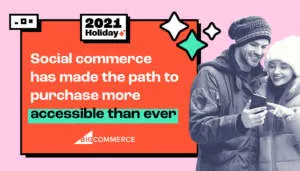Boost Sales with Social Commerce This Holiday Season

Pumpkin spice is in the air and the holiday season is upon us. And with holiday sales expected to spike as much as 9% in 2021, now is the time to refine your sales strategy to make sure you’re set up for success.
One way to boost your sales and reach new shoppers this season is by adopting new sales channels.
With more and more shoppers taking to social media to explore brands and products, Meta Technologies including Facebook and Instagram can help give you the added visibility you need.

In fact, 45% of North America Holiday 2020 shoppers shared their product discoveries via social platforms, further amplifying merchants’ efforts.
Social commerce has made the path to purchase more accessible than ever by allowing brands to sell directly from the platforms where shoppers are spending the most time.
“A strong omnichannel strategy is all about meeting your customers where they are, and this is more important than ever during the holiday season. With 3.45 billion people on Facebook and 1 billion people on Instagram, those channels can help merchants reach more people and drive more sales. But it’s important to remember that shoppers expect a seamless shopping experience across channels, from websites to brick-and-mortar stores to social media.”
— Sharon Gee, VP, GM of Omnichannel, BigCommerce
Let’s dive in with our tips and tactics to ensure that you’re creating a seamless experience with your social commerce channels.
Optimize Your Shops on Facebook and Instagram
1. Connect your product catalog (if it’s not already).
Connecting your BigCommerce product catalog with Facebook and Instagram is quick and easy and will allow shoppers to easily discover your products, share them with friends and checkout directly from your Shops on Facebook and Instagram. Orders from Facebook and Instagram are managed from BigCommerce just like storefront orders.
Once you connect your BigCommerce store to Facebook via Channel Manager, you can start tagging your products from your catalog directly in your Facebook and Instagram photos. Users can discover more information about your products and can link directly to your store for purchase.
Stores based in the US can also apply for and enable checkout on Instagram, which allows shoppers to purchase the products they discover on Instagram without ever leaving the app. When enabled, new products you tag in posts will use the in-app checkout process instead of redirecting to BigCommerce for checkout.
Just a reminder: Checkout on Instagram is only available to US stores and shoppers using USD currency.
2. Tag your products frequently.
Every month, 130 million people tap on product tags to learn more about products they see on Instagram. Product tags enable you to highlight products from your BigCommerce catalog and help customers learn more about what you’re selling.
The most successful businesses use product tags frequently across different formats (feed, stories, Reels, IGTV, captions and Live) since people spend time in various places on Instagram.
Product tags are not only essential for giving shoppers an easy way to find your brand, but also to make a convenient purchase. Product tags should be a part of your baseline Instagram strategy, and you should leverage them whenever posting images of products.
According to Facebook data, merchants that tag 5+ days per month on their feed, see on average:
278% increase in product page visits
231% increase in purchases
216% increase in sales
By using product tags consistently, you create more shoppable posts that can help you reach new shoppers and get the most out of your shop.
3. Design your shop to reflect your brand.
Once you enable Shops on Facebook and Instagram, you get access to merchandising features to curate and customize the shopping experience for your customers.
Products can be organized with collections around seasonal moments such as holiday promotions and upcoming launches. Visual merchandising can also provide a custom look and feel to highlight your brand. Remember to arrange the layout and order of your collections so that people see your new and featured collections first.
4. Make your content actionable.
“A strong call to action, or CTA, is critical to any marketing campaign, and Facebook/Instagram Shops are no different. Don’t just assume that shoppers know what action you want them to take; rather, make sure you tell them in a way that’s clear and compelling.”
Melissa Dixon, Director of Content Marketing, BigCommerce
Consumers engage with shoppable posts and videos throughout the app. Regularly creating engaging and actionable posts about your products across posts, Reels and Stories can help amplify your reach while building shopping behaviors.
Use clear calls to action to inform consumers how to shop for your products on Instagram.
Update your Instagram profile to let shoppers know that they can buy from you directly on Instagram. For example, adding phrases like “Start shopping below” to your profile will help clarify that visitors, especially new customers, understand they can shop your product directly via Instagram.
Spark an Emotional Connection with Shoppers
1. Share your brand story and mission.
People are wanting connection with each other, businesses and their communities — especially during the holidays. More consumers are looking more into a brand’s mission and what they represent before they make a purchase.
Here are some ways to share your brand story this holiday season to increase engagement:
Team up with a charitable organization
Find a charitable organization that’s important to you to highlight your mission and give back. An easy and affordable way to enable your customers to give back is by offering digital donation options at checkout.
With the right app integration in place, you can select a specific charity or allow customers to choose a charity of their choice to contribute to. A couple of app integrations to consider are:
RoundUp: This free integration allows your customers donate spare change to a charitable organization by simply rounding up their order (e.g. $15.50 to $16).
ShoppingGives: Customers choose a charitable organization of their choice to support, and you pledge a donation on their behalf at checkout — and all donations are tax-deductible.
Highlight and promote user-generated stories
Celebrate your customers and show your appreciation for them by creating personalized messaging that makes your customers feel seen and heard. Brands like Stacked By Suzie are great examples of amplifying user-generated content in their posts and stories.
2. Consider an influencer marketing strategy.
When we’re looking for recommendations, who and where do we go? Many times it’s someone we know personally or follow online. They also often have these characteristics:
Honest and authentic
Trustworthy
Share the same values
Now, let’s consider a recommendation by word-of-mouth, you’re not sure what the product looks like or where to shop for it – enter influencer marketing on Instagram.
The more interaction shoppers have with a product, the more familiar, comfortable and confident we feel purchasing it. Brand-led communication, like influencer marketing campaigns, is a key tactic to connecting users to a brand – both to its voice and products.
This marketing strategy is a brand’s early step to creating an engaged relationship with consumers. There are different types of influencers to consider as well from a strategic standpoint.
Different Types of Influencers
Influencers fall into different niches, different followings, and have different ways of creating content. It’s important to understand what type of influencer will work best for your brand (taking into consideration both budget and relevance).
The four groups are:

Nano-influencers: Nano-influencers typically have less than 10,000 followers and resemble everyday people – like your family and friends.
Micro-influencers: Micro-influencers have less than 100,000 followers and are often known as an industry expert or topic specialist in a specific niche. They are similar to nano-influencers.
Macro-influencers: Macro-influencers have between 100,000 and 1 million followers. Sometimes these influencers can be celebrities, but often are just micro-influencers who have continued to grow their following base. Instagram influencer marketing is their full-time job.
Mega-influencers: Mega-influencers have more than 1 million followers. These influencers tend to be celebrities or major public figures.
By finding the right influencer that aligns with your brand and matches your target audience, you can enable your shop for success. If you are interested in learning more about influencer marketing, click here.
3. Create an editorial calendar to plan your posts.
Identify what cultural moments matter to your brand and your audience especially this holiday season, then create content relevant to those moments. This planning ahead will not only be beneficial for your upcoming product launches and announcements, but helps establish an emotional connection with customers and build brand affinity.
All these tactics are a great way to connect with your audience and sell more with social commerce this holiday season.

Elizabeth Hudson is a Content Marketing Manager at BigCommerce, where she specializes in content strategy and writing on all things for omnichannel marketing. She previously worked at IBM, focusing on content and product marketing.


